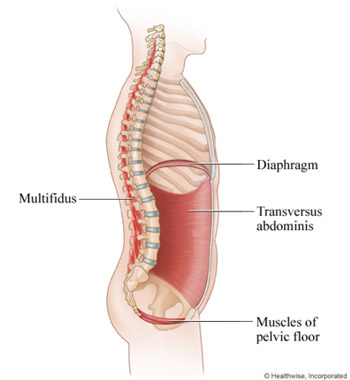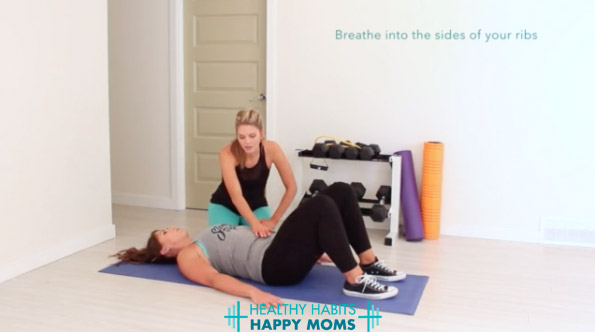Recommended Reading:
Your Diastasis Recti Questions Answered
Diastasis Recti Test
Core Exercises Postpartum Women Shouldn’t Do
The education we receive about our pregnant and postpartum bodies continues to be dismal at best. From the awful “just keep doing what you were doing before you were pregnant” advice to the six-week clearance for exercise, I’m continually shaking my head wondering when it will stop. Simply put, once we are pregnant and postpartum, our bodies are different and require a different training approach. It just makes sense!
Why Can’t I Flatten My Tummy After Childbirth?
One of the complaints I hear most often from postpartum women is that they can’t seem to flatten or “tone” their stomachs months or even years after birth. They complain about the “mummy tummy” or the “spare tire” around their waists. I always ask these two questions:
1. Do you have diastasis recti?
2. Have you ever done a postpartum rehab program that reconnects your deep core muscles?
The answers I usually get are “dia-what?” and “uh… No.”
Related: What Is Diastasis Recti?
The next question I ask is sometimes uncomfortable, but as your trainer, I absolutely need to know this (and so do any personal trainers or health professionals who work with pre or postnatal women!).
“Do you ever leak when you work out? Jump? Sneeze?”
And it’s not uncommon for the answer to be “yes.”
Diastasis recti and pelvic floor issues are related. If a woman has one, it wouldn’t be surprising for her to have the other (although they present separately as well!). They are both symptoms of having an uncoordinated core and faulty internal pressure system.
What Is “The Core?”
When I’m talking about your core, I don’t mean your abs. I’m talking about your deep core, the muscles that stabilize you and should turn on before any movement. These muscles include the diaphragm, transverse abdominis, multifidus and pelvic floor muscles. And it’s this system of muscles that needs to be addressed with core exercises before you start working on the exterior.
Core Exercises for Early Postpartum
I consider “early postpartum” as approximately 0-3 months after childbirth, but could be even later. Women months, year, even decades after childbirth may be facing the same challenges as my early postpartum clients because they never reconnected with their cores. Until you address it, these issues won’t go away!
Here are three core exercises that every early postpartum woman should do to reconnect with and strengthen their deep core system.
1. Piston Breathing
Why: During pregnancy many women’s breathing patterns suffer from terrible alignment and the upward pressure from the baby on the diaphragm. The very first exercise a woman should do after childbirth is breathing life back into her core. The sooner we can coordinate the pelvic floor with our breath, the better.
How: Lay on your back and find neutral alignment (pelvis untucked, gentle curve in the lower back, ribs over hips). Relax fully. Bring knees to a 45 degree angle. Start inhaling deeply through the nose and exhaling fully through the mouth. With each inhale relax your pelvic floor. You should feel as if a balloon is being blown up inside of your pelvis. On exhale gently contract your pelvic floor muscles at about a 10-30% contraction. Do this as often as possible and in different positions: laying, sitting, standing.
When: Breathing core exercises can be started 1-2 days after childbirth.
** Pssst! We go over piston breathing in detail in our Postnatal Program!**
2. Heel Slides
Why: During pregnancy our Transverse Abdominis muscle (TA) stretches out like an elastic band. We need to reconnect with this muscle and bring it back onto the “team” to function with the rest of the deep core muscles.
How: Lay on your back and find neutral alignment (pelvis untucked, gentle curve in the lower back, ribs over hips). Bring knees to a 45 degree angle. Start your piston breaths. On exhale, slide one foot down until your leg is straight and then bring it back to where you started. You should feel a gentle contraction in your deep core with each slide. Repeat with the other side.
When: 2-6 weeks after delivery, or doctor’s clearance for exercise.
3. Glute Bridge
Why: After a woman has a baby she spends quite a bit of time sitting (nursing, rocking, resting). It’s important to wake up those glutes and keep them strong. Weak glutes make women more susceptible to pelvic floor disorders.
How: Lay on your back and find neutral alignment (pelvis untucked, gentle curve in the lower back, ribs over hips). Bring knees to a 45 degree angle. Start your piston breaths. On exhale push up from the heels and move through the range of movement you have while keeping yourself in neutral alignment. The goal is not to press as high as possible.
When: 2-6 weeks after delivery, or doctor’s clearance for exercise.
Where to Go From Here
In my next few blog posts I will be talking about core exercises you can start incorporating when you’ve reached late postpartum, or after completing my Early Postnatal Series.


I didn’t know I had diastasis recti until two years postpartum, when I had already been working out for a year, and didn’t know why, when I stretched my arms up or leaned back, I had a ridge down the middle of my abdomen. I backed off of core work and did some research. I tried going through a couple of other programs geared toward healing diastasis recti, but saw little change. That was three years ago. I stuck with working out, but basically leave out or severely modify anything that requires “traditional” core work. One day I hope to earn some postnatal certifications to help myself and others truly heal their cores. I’m still trying to heal my core, and I really appreciate the work you do. Thank you for sharing these exercises.